Considering using LearnDash to create online course content with WordPress?
LearnDash is a popular WordPress LMS plugin that works for both serious academic institutions, solo course creators, and everyone in between.
It can help you create unlimited courses, add unlimited lessons and topics, quiz your learners, require assignments, etc. It also includes built-in features to charge one-time or recurring access fees, as well as advanced features like content dripping, course prerequisites, and more.
Overall, it’s definitely one of the top options when it comes to WordPress LMS plugins. And in our hands-on LearnDash review, we’re going to take a detailed look to help you decide whether this plugin is right for you.
Here’s how we’ll break up our LearnDash review:
- Thoughts on the types of users who can benefit from LearnDash
- A hands-on look at how LearnDash works
- Seven pros and two cons of LearnDash
- FAQs about LearnDash
- Final thoughts
Let’s dig in…
Who Is LearnDash For?
LearnDash is a pretty flexible plugin that can benefit both academic institutions as well as businesses, solo creators, and more.
On the academic front, LearnDash supports SCORM and Tin Can API (xAPI) for heavy-duty implementations. The ProPanel feature is also well-suited to academic institutions, as it offers quick assignment management, emailing features, and more detailed learner information/analytics.
However, LearnDash can also be quite effective for more small-scale uses, too.
For example, if you’re a solo course creator, LearnDash can help you create and deliver free or paid course content to your members, which makes it a great solution for monetizing your site with online courses.
It can also be useful to businesses that want to provide training to employees. You can use LearnDash to set up employee onboarding or certification and track your employees’ progress to make sure they’ve completed all the relevant education materials.
All in all, you have a lot of different ways to use LearnDash, which is why it’s one of the top WordPress LMS plugins.
How LearnDash Works
In this section, I’ll give you a general overview of what it’s like to create course content with LearnDash. Then, in the next section, I’ll single out some specific pros and cons.
Basic Setup
When you first activate LearnDash, it launches a “bootcamp” guide to show you all the actions you need to take to set up LearnDash. Each step includes a video and text article, and you can mark them as complete as you go through them:
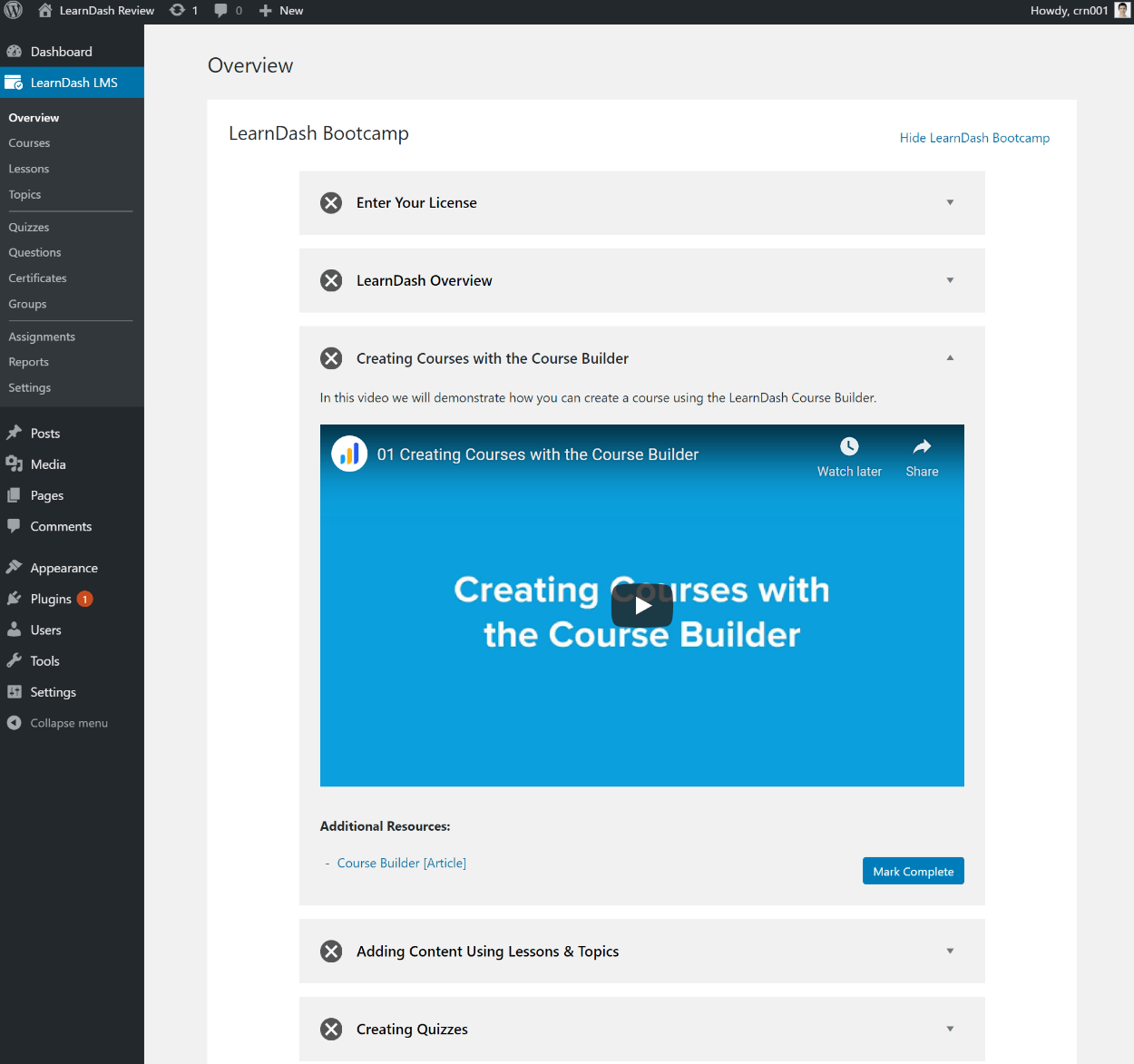
Overall, I think this is really convenient as it helps you make sure you’re not missing anything important.
Creating a Course
Your first step is to add a course. Each course can include unlimited lessons, topics, quizzes, assignments, etc.
When you create a course, you’ll see the native WordPress block editor (for the course listing page content), as well as tabs across the top to configure additional options:
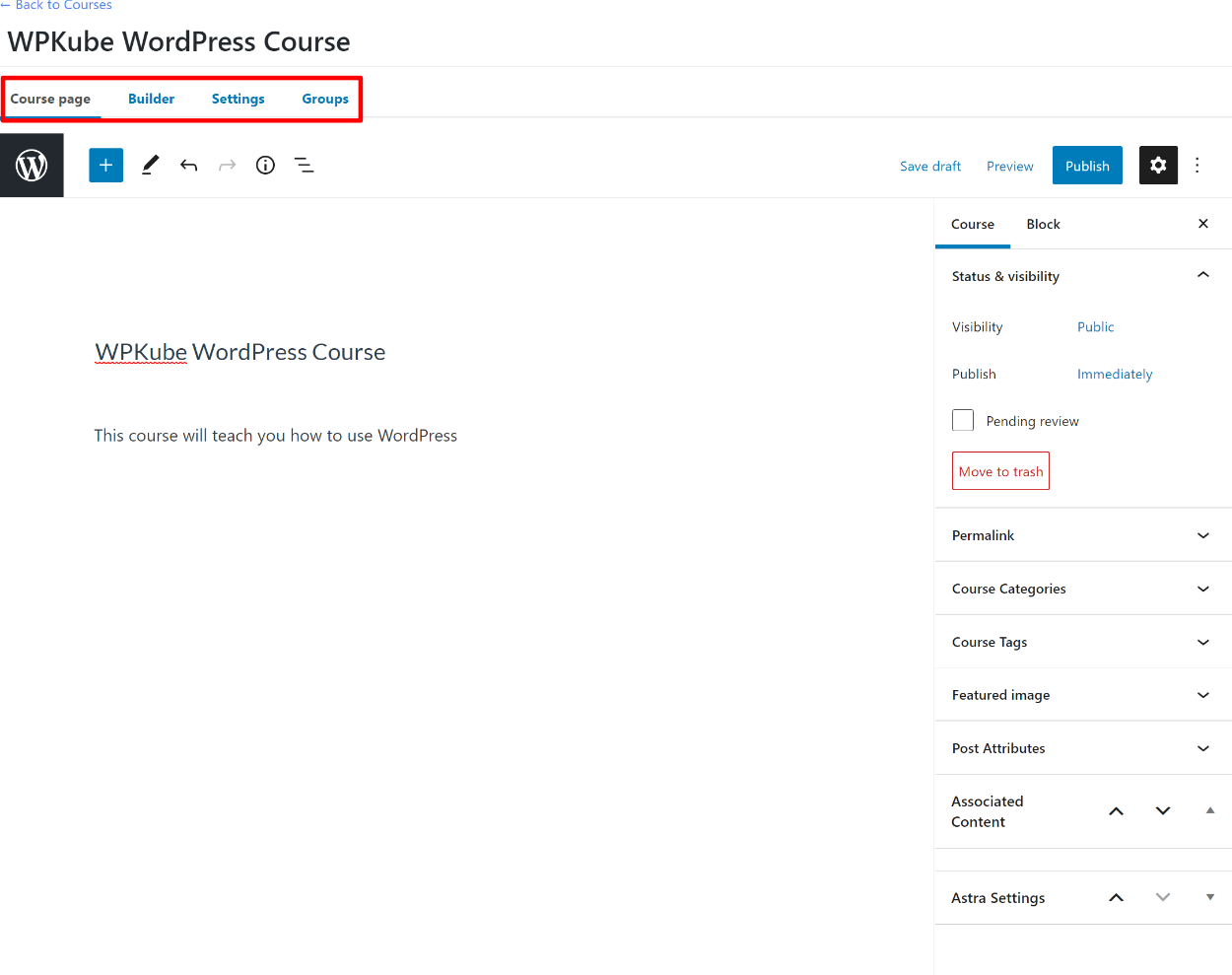
Using the Course Builder
The course builder is one of the most useful features in LearnDash as it lets you set up the structure of your lessons, topics, quizzes, and more using a simple drag-and-drop interface.
Lessons are the main knowledge block, and then you can subdivide lessons into topics.
You can use the buttons to add new lessons, topics, and quizzes and then drag-and-drop things to rearrange them as needed:
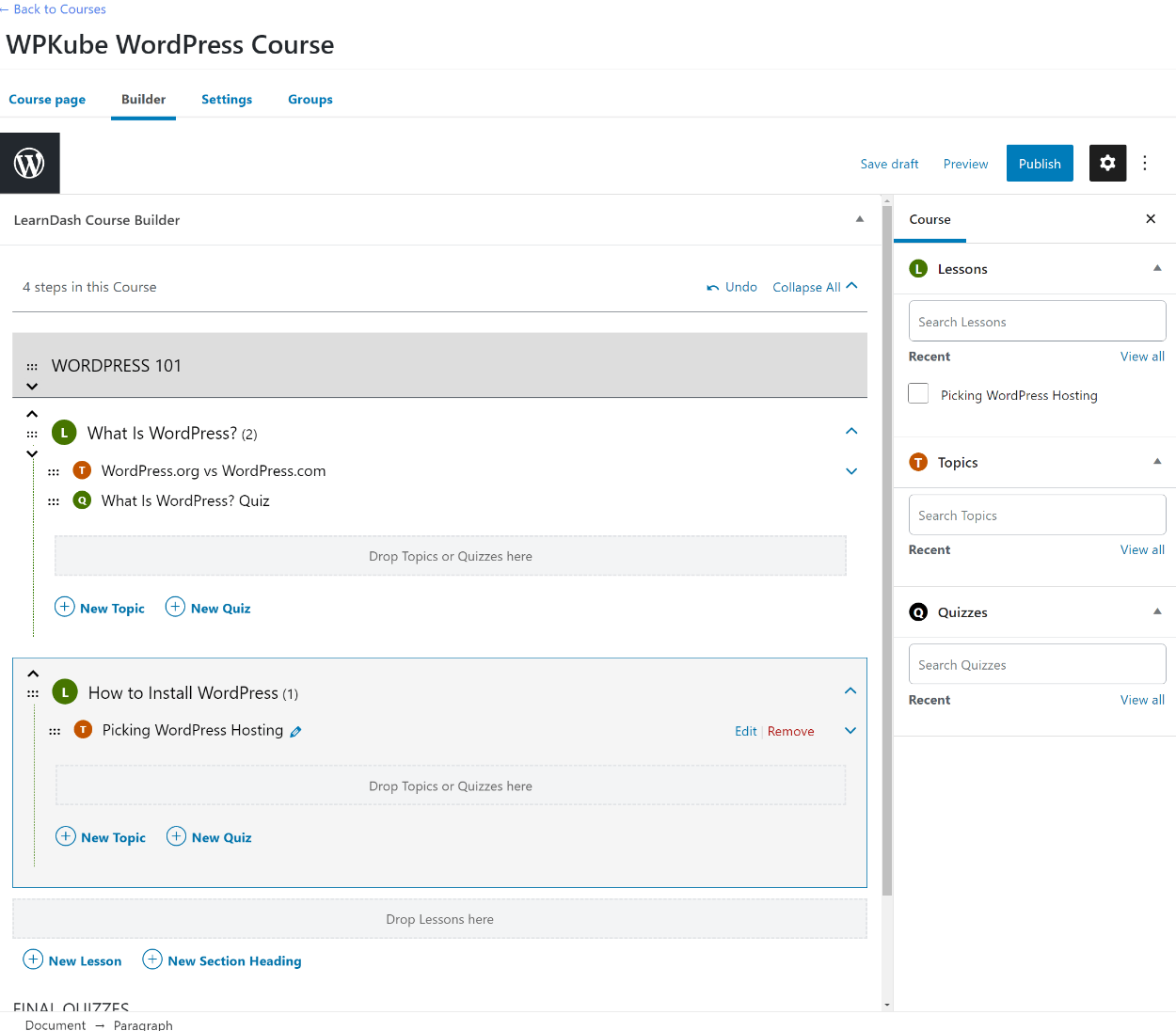
Adding Lessons/Topic Content
Once you’ve added the high-level structure of your course using the builder, you can open the editors for individual lessons/topics to add the content for those units.
When you add a lesson/topic, you can add the content using the regular WordPress block editor. You’ll also get a useful Associated Content box in the sidebar to let you see how this unit matches up to other topics:
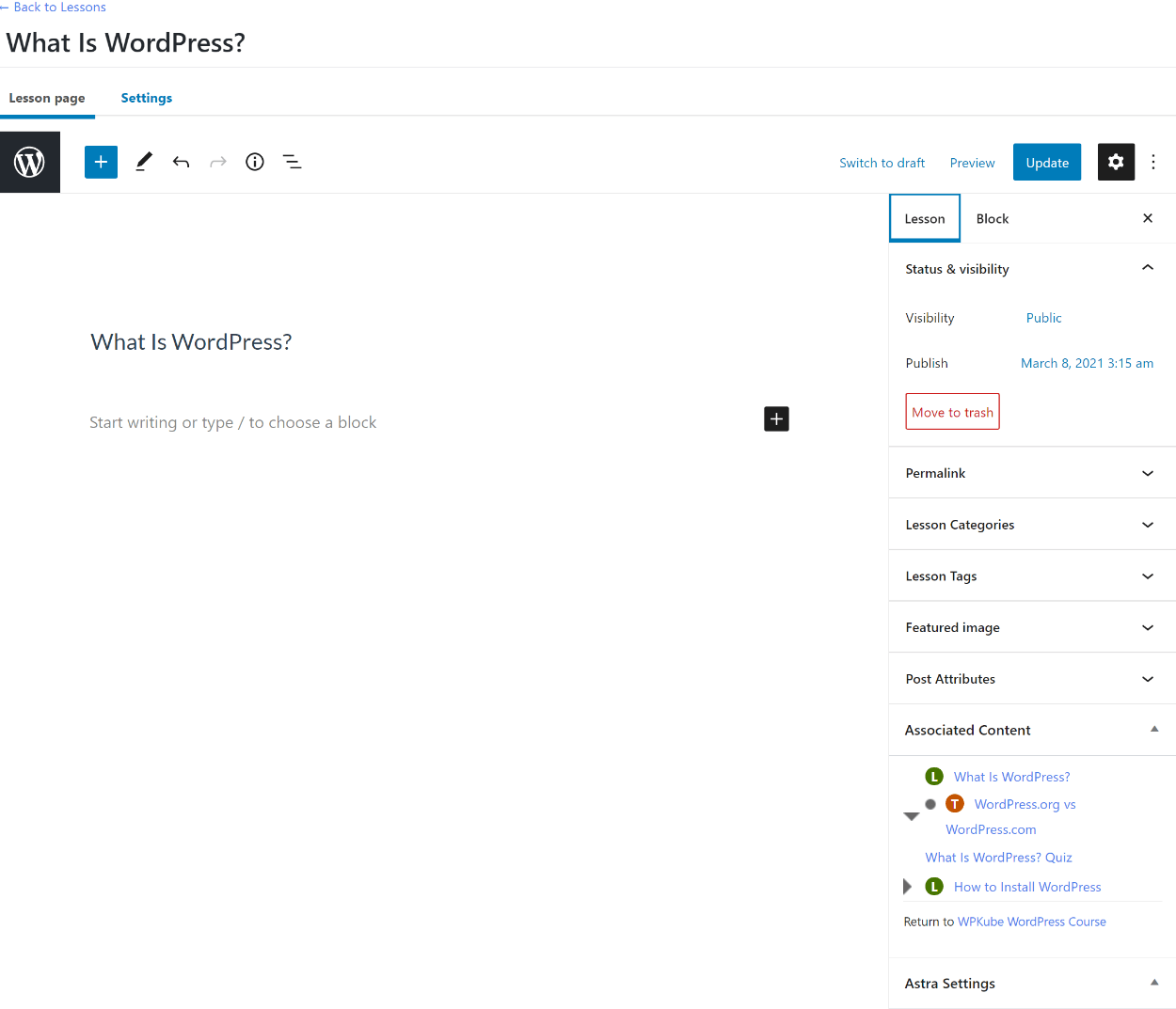
In the Settings tab, you can also add a dedicated video that users must watch to complete the lesson, as well as configure other features like:
- Lesson materials (e.g. a PDF checklist)
- Assignments
- Lesson timers
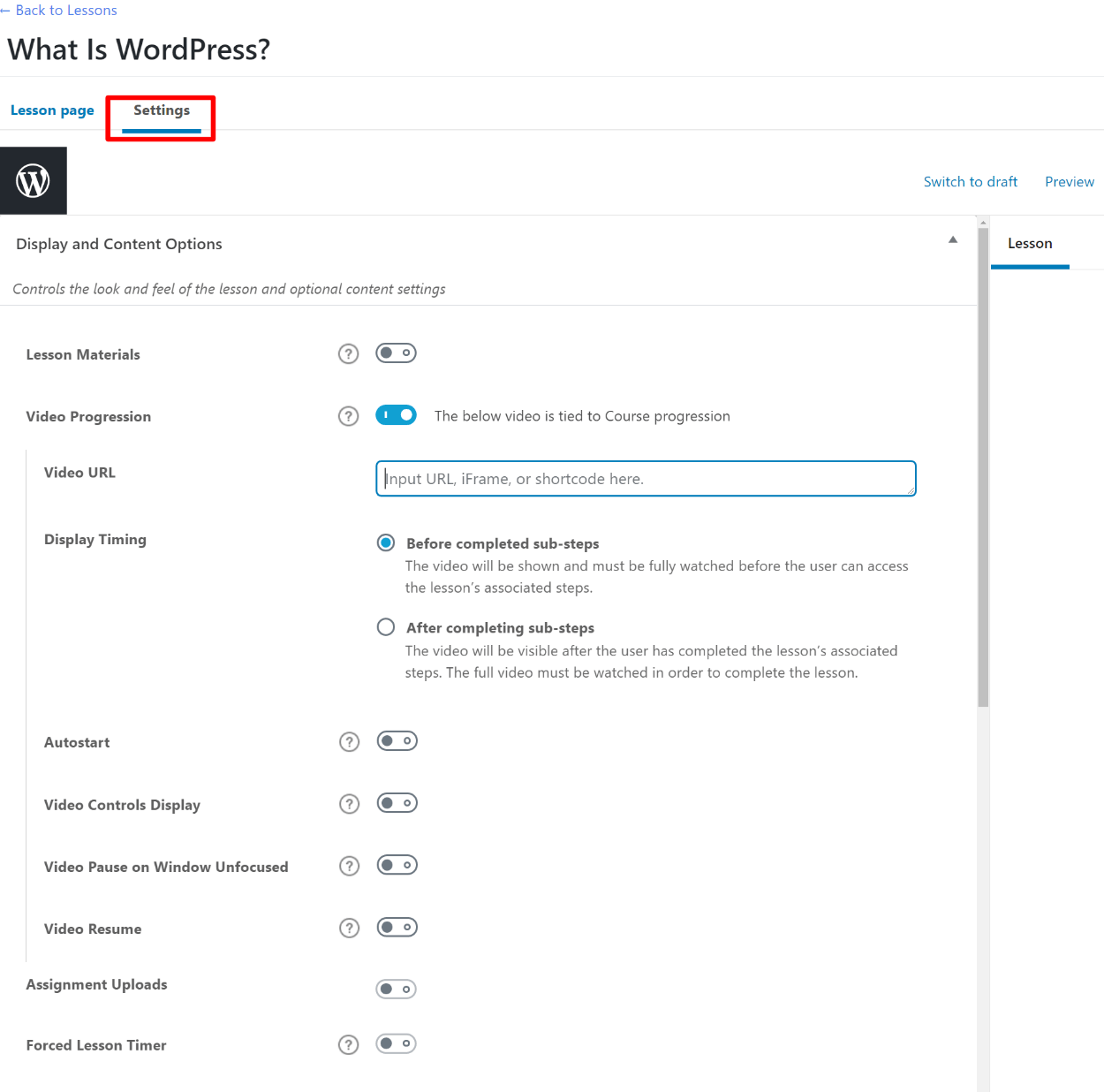
Adding a Quiz
To add a quiz, you’ll get a dedicated quiz builder that works a lot like the course builder.
You can add different questions and use drag-and-drop to change their order:
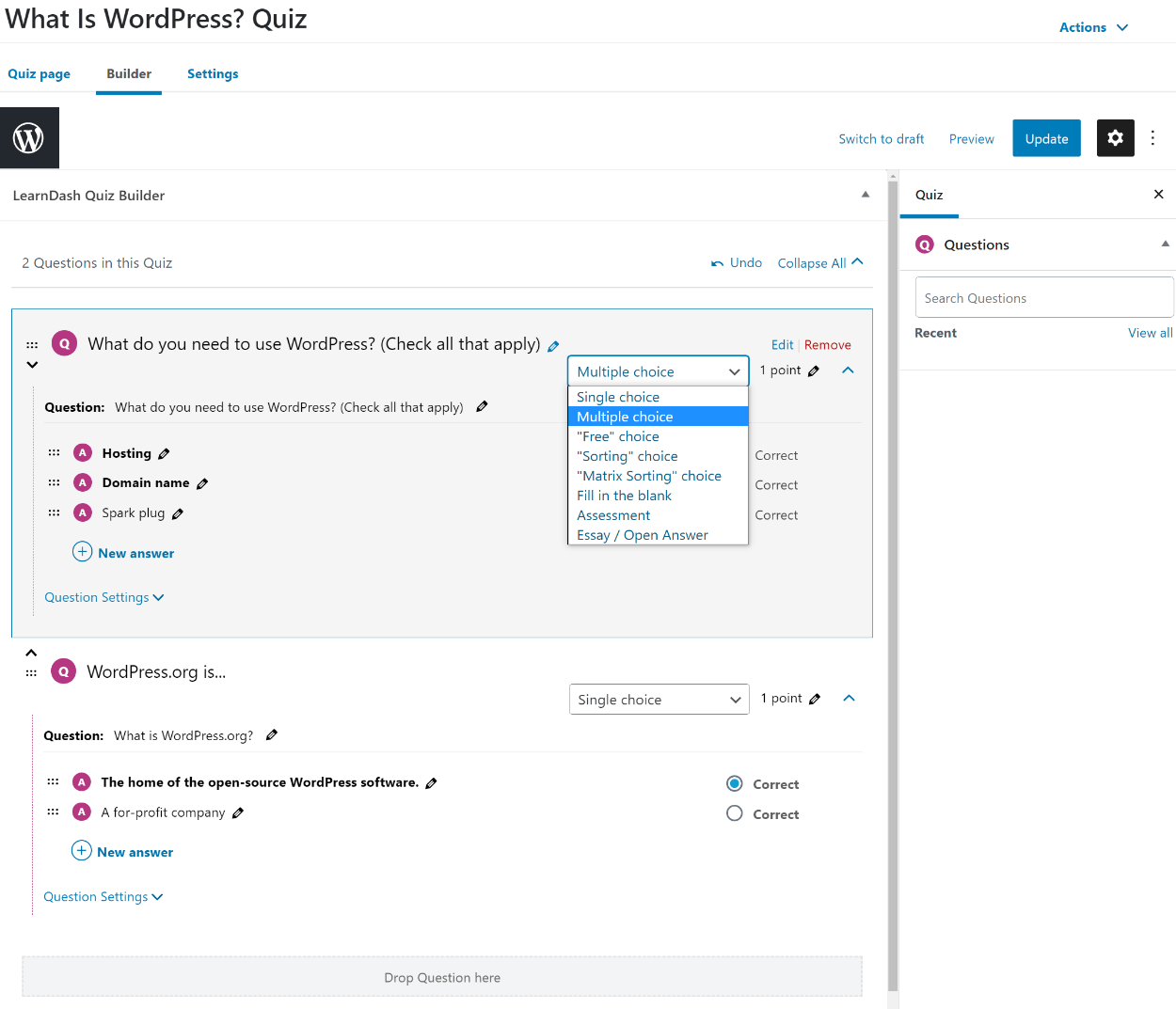
If you go to the Settings tab, you can configure more advanced options like the passing score, retakes, question order randomization, a quiz certificate, quiz timer, and more.
Setting Up Course Access
Once you’ve added and organized your course content, the next step is to control access to your course, which you can do from the course’s settings.
You have five options:
- Open – anyone can access the course. It’s public on your site.
- Free – the course is free, but people need to register and enroll for it.
- Buy Now – people pay a one-time fee for access.
- Recurring – people pay a recurring fee for access.
- Closed – you must manually add learners (or use a separate payment/membership plugin).
You can also set up other restrictions, such as course prerequisites and access expirations:
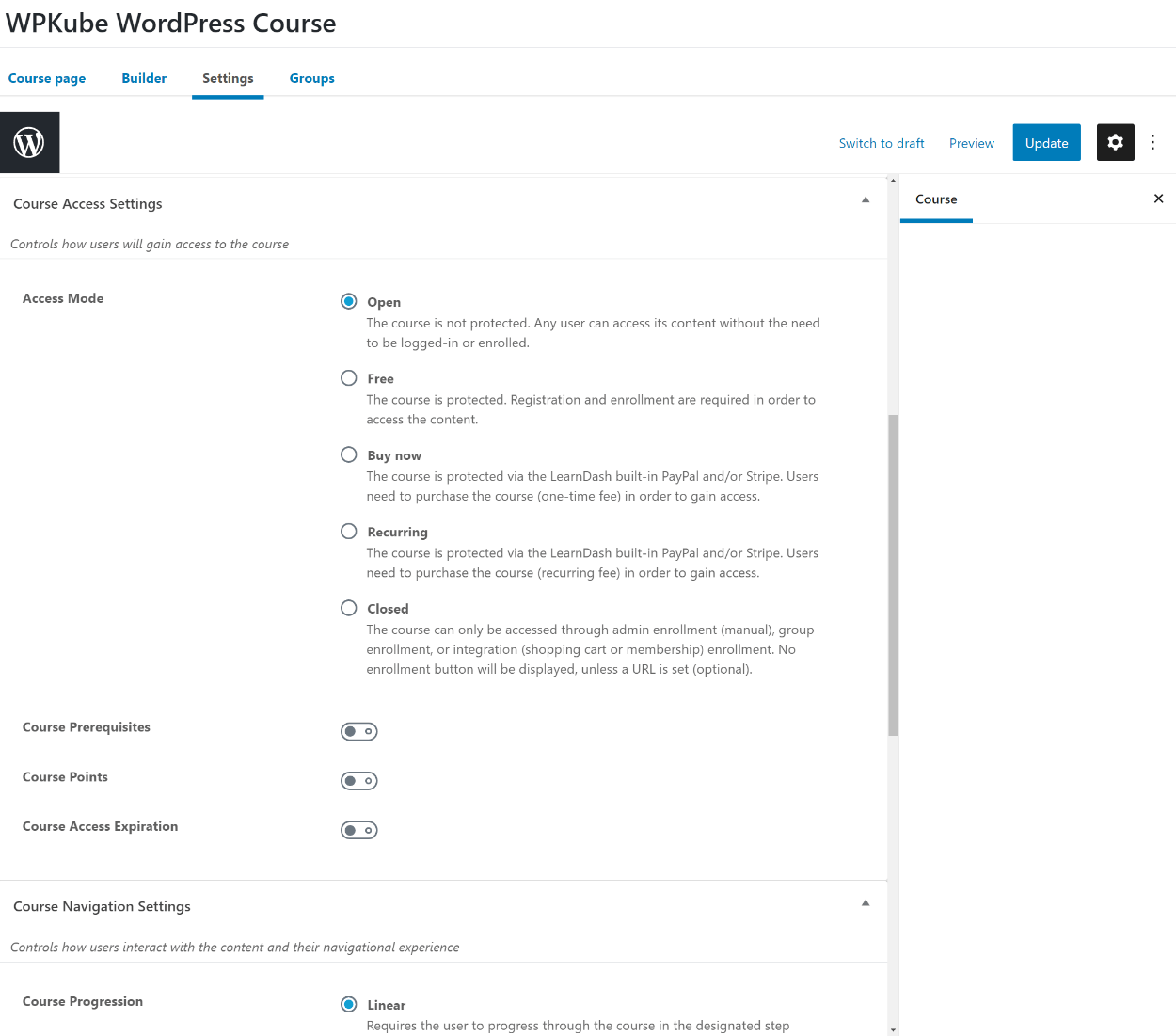
And that’s a general high-level look at what it’s like to create a course with LearnDash. Of course, I didn’t cover nearly every feature, because there are a lot of small options. But you should have a good idea of how it works.
LearnDash Pros and Cons – 7 Pros and 2 Cons
Now, let’s dig into some of the specific things that LearnDash does well…and some of its weak points.
LearnDash Pros
1. User-Friendly Drag-and-Drop Builder
I showed you the course builder in the tutorial, but it’s worth highlighting again because it’s such a useful feature.

When you have a lot of lessons, topics, and quizzes, it can be hard to visualize how everything fits together and the progression that your students will follow as they move through the course.
Having the course builder interface not only makes it easy to see how everything fits, but it also lets you easily make changes using drag-and-drop.
It also just generally speeds up your course building because you can easily open the editors for all the course’s content from one spot.
2. Excellent Front-End Learning Experience
When thinking about LMS plugins, it’s easy to focus on all the backend features. Those are certainly important, but it’s also very important to think about the experiences that your learners will have on the front-end.
LearnDash doesn’t ignore this and it’s created one of the best front-end experiences out there. Learners get a really nice distraction-free interface, along with useful features like progress bars, tables of contents, etc.
Look at how great this looks:
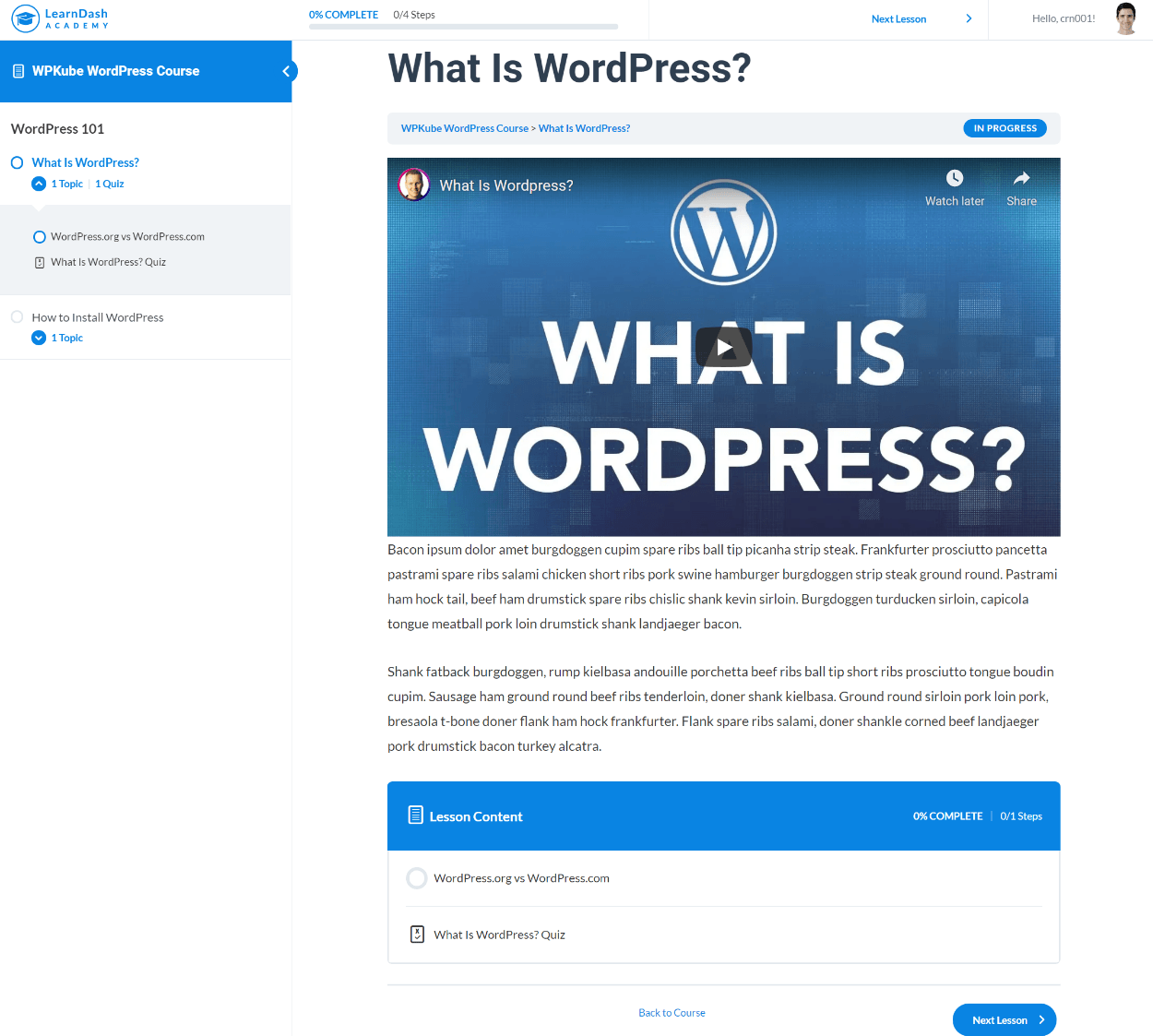
This is using one of the free LearnDash demo sites in the free Astra theme.
You get a lot of useful features here including:
- The table of contents for the entire course on the left.
- The course progress indicator at the top.
- The lesson content list.
- The front-and-center video.
- The user-friendly navigation to jump to the next lesson.
Of course, your theme might look slightly different. But the point remains that LearnDash helps you create a really great front-end experience for your visitors.
3. Detailed Video Content Support
Video course content is huge nowadays, so it’s key that LearnDash includes special features to handle video content.
You’ll get built-in features to add video to lessons and topics – you can even add a video preview for your course.
You can also require learners to watch a video as part of the course progression, and even automatically play/resume a video as soon as people open a lesson.
4. Flexible Quiz Builder
LearnDash has one of the better quiz builders of all the LMS plugins that I’ve tried. It’s basically the same as the drag-and-drop course builder – and I’ve already explained why I like the drag-and-drop course builder so much.
What I really like, though, is that you can set up all of your questions and answers without needing to open a separate interface or popup. This makes the process go a lot quicker and also lets you see how everything comes together from one spot.
You also just generally get a lot of questions and settings, including lots of options for setting up advanced quiz behavior like passing grades, randomization, timers, and more:

5. Advanced Features (Drip Content, Prerequisites, Etc.)
LearnDash just generally includes some flexible features for configuring how your courses work.
For example, to keep your students engaged and coming back, you can “drip” out course content. You can either release the content on a set schedule based on the user’s enrollment date or use a fixed schedule for all learners:
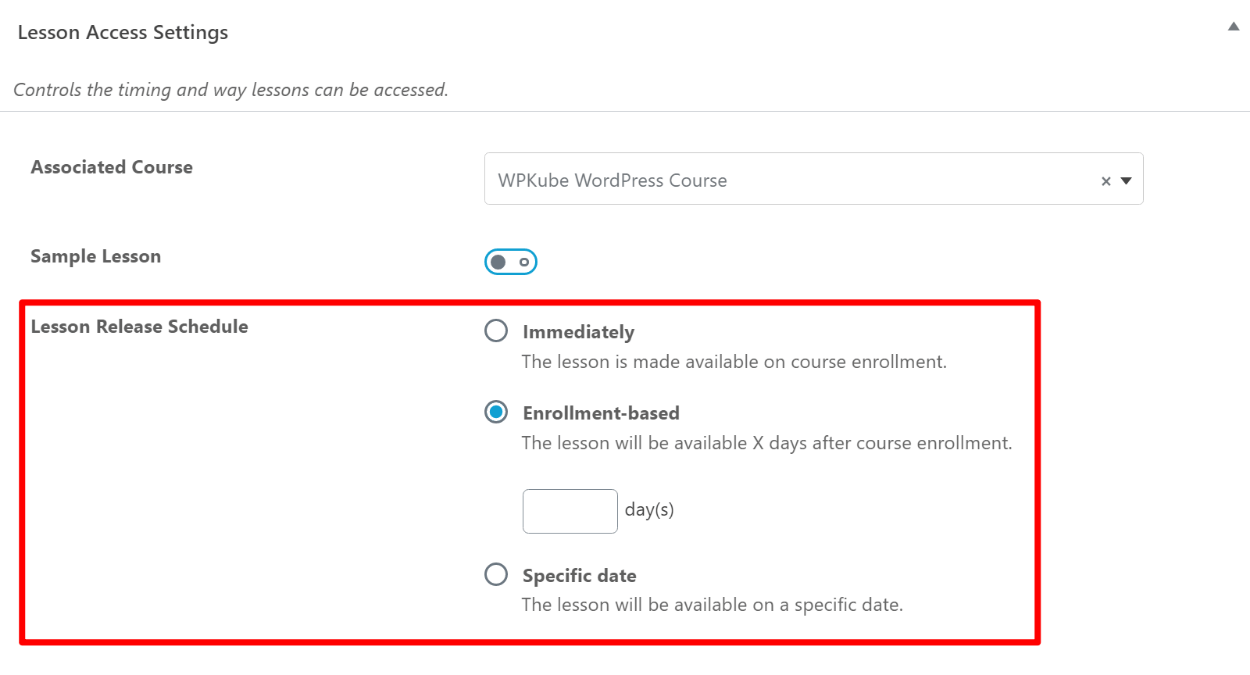
You can also require users to take one or more course prerequisites before they can enroll in a course:
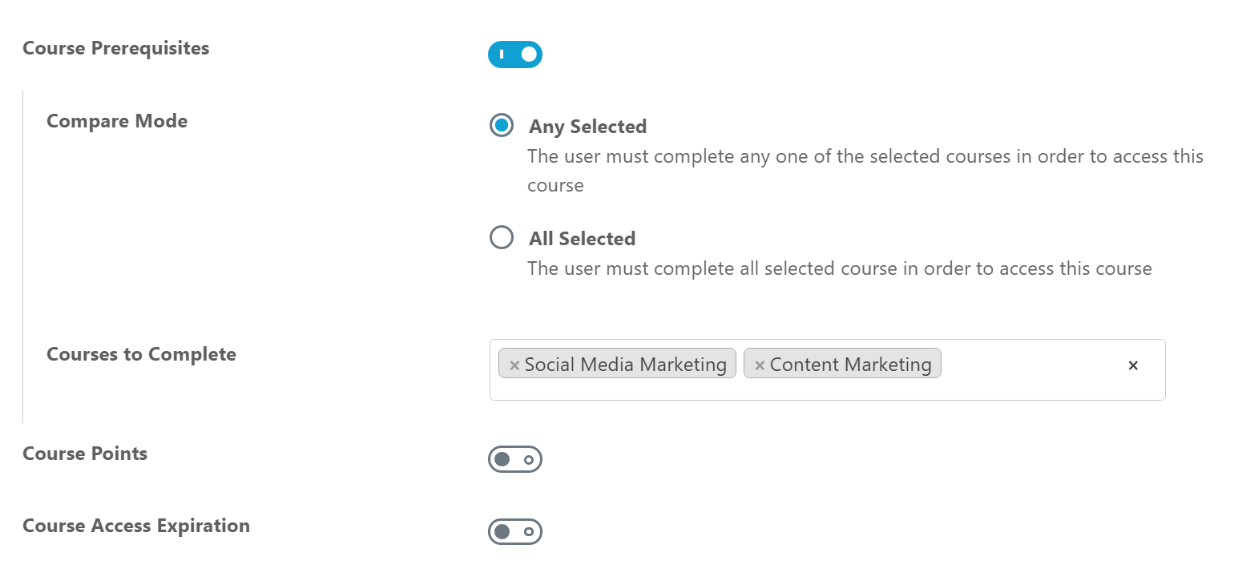
All in all, it’s pretty flexible when it comes to setting up your courses.
6. Automation Rules via Engagement Triggers
One feature I didn’t touch on in the tutorial is LearnDash’s engagement triggers, which let you set up your own custom email automation rules for your course.
You can set up your own trigger notifications based on user actions such as:
- Joined/completed a course
- Completed a lesson/quiz/topic
- Submitted an assignment
- Etc.

This is great for marketing, UX, and otherwise setting up automation.
7. Vibrant Third-Party Extension Marketplace
In addition to the many official extensions and integration plugins, LearnDash also has a vibrant third-party marketplace, which makes it very easy to extend your course with new features. For example, some of the many third-party extensions that you can find include:
- Course ratings and reviews
- Multiple instructors (like Udemy)
- Front-end course creation
- Private messaging
- Custom course checkout and upsells
- …lots more
LearnDash maintains a support page that lists some of the most popular third-party plugins.
LearnDash Cons
Now, let’s talk about the bad stuff…
1. Built-In Payment Options Are Limited
While LearnDash includes built-in features for one-time and recurring payments, they aren’t as flexible as what you’d get with a full membership plugin or another LMS plugin like LifterLMS.
For example, you can’t set up free trials or one-time signup fees. You also can’t offer coupons and promos.
You can accomplish all of this by using a third-party plugin like WooCommerce or integrating with a membership plugin – it’s just not something in the core LearnDash plugin.
2. Built-In Membership Options Are Limited
LearnDash includes some basic membership features as far as they apply to your courses. That is, you can restrict access to a course to only authorized users.
However, it doesn’t set up membership features for your site as a whole. For example, if you wanted to restrict access to a regular page for only certain types of learners, you couldn’t do that with the core LearnDash plugin.
Thankfully, LearnDash does integrate with virtually all popular WordPress membership plugins, so you can easily add more advanced membership features if needed.
LearnDash Pricing
LearnDash only comes in a premium version, but it’s priced quite competitively vs many of the other LMS plugins. You can also save some money with our special LearnDash discount.
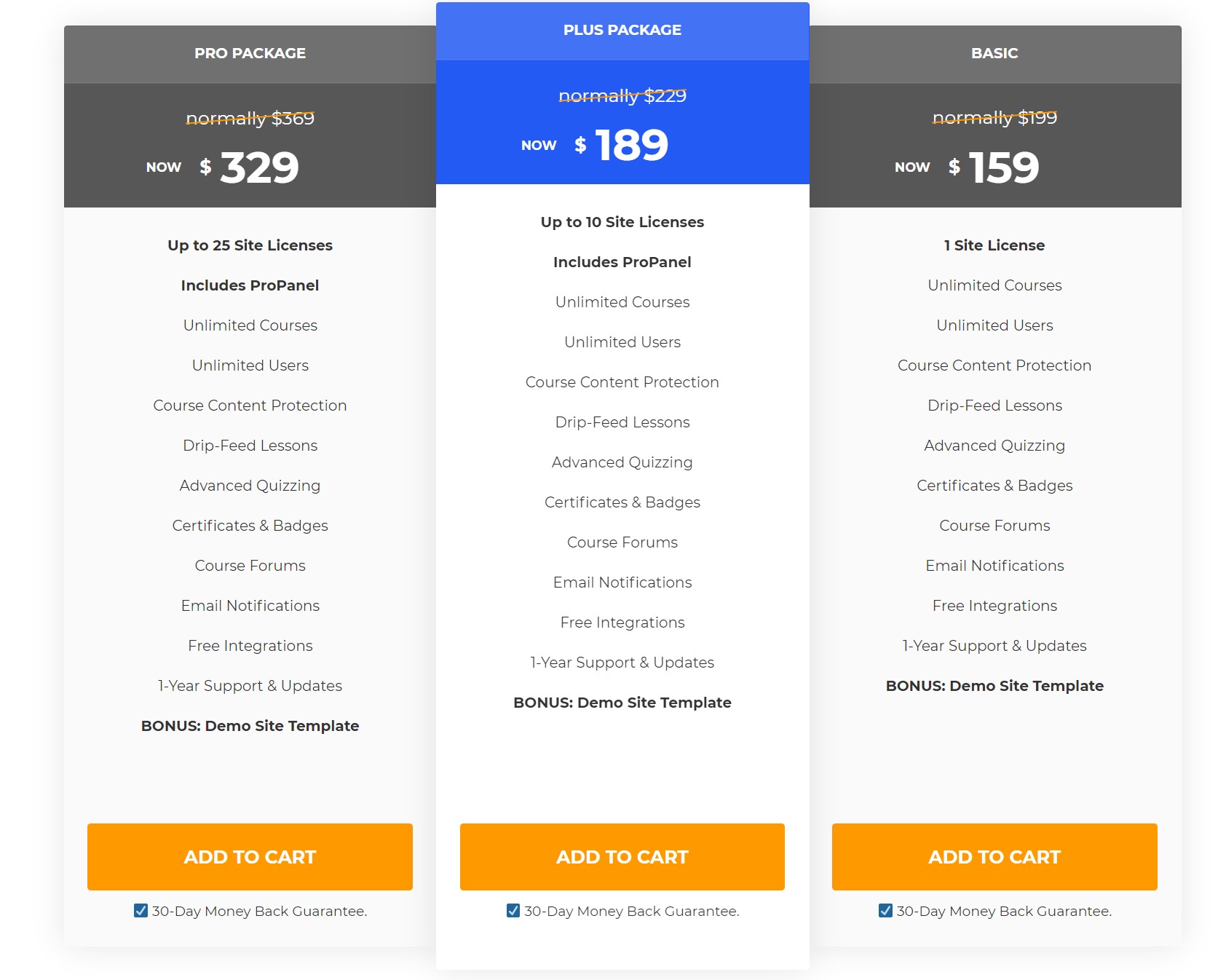
LearnDash Review FAQ
To finish things out, let’s go over some frequently asked questions you might have about LearnDash and our LearnDash review.
Is LearnDash easy to use?
Yes, LearnDash is easy to use in that it’s 100% code-free and you can build your courses using a simple, drag-and-drop editor. It does have a lot of features, so there might be a small learning curve to figure out how everything works. However, you definitely don’t need any special technical knowledge to use LearnDash.
Is LearnDash scalable?
Yes, LearnDash is very scalable. In fact, that’s one of the features that makes it stand out against other LMS plugins. Because of its more heavy-duty features (like ProPanel), LearnDash can easily scale to a high volume of students and courses.
Of course, you’ll need high-quality hosting to match, so you shouldn’t expect to run a heavy-duty LearnDash setup from cheap shared hosting.
Is LearnDash free?
No – LearnDash only comes in a premium version and they don’t offer free trials. However, they do have a 30-day refund policy and you can also play around with a demo to try it before you buy.
Who uses LearnDash?
LearnDash makes a great option for serious academic institutions, as well as solo course creators looking to create/monetize online courses and small businesses looking for an affordable solution for employee training.
Final Thoughts On Our LearnDash Review
Overall, LearnDash definitely earns its spot as one of the best WordPress LMS plugins.
In terms of pure functionality, I think its only close rival is LifterLMS (our review). LifterLMS can be cheaper if you just need simple courses. However, if you need detailed quiz functionality and other advanced features, LearnDash is usually a lot more affordable.
For that reason, I feel confident recommending LearnDash as a great option for anyone looking to create online course content with WordPress, no matter if you’re a solo creator, a business looking for an employee training solution, or a serious academic institution.
To make sure you’re getting the best deal, make sure to use our exclusive LearnDash discount.
If you want to get started, the Astra theme makes a great companion for LearnDash because it comes with built-in demo sites and features for LearnDash. Or, you can check out our collection of the best WordPress education themes for some other options.
Still have any questions about LearnDash or our 2022 LearnDash review? Let us know in the comments!

